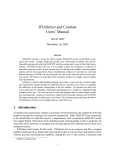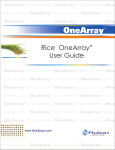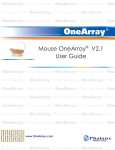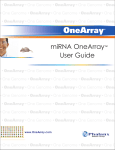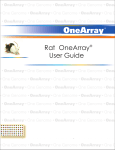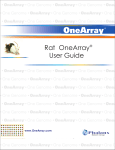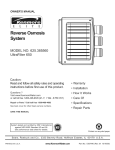Download User Guide Yeast OneArray®
Transcript
Yeast OneArray User Guide www.OneArray.com ® Notice to the User IMPORTANT! It is important that users read the entire manual before commencing work. Phalanx Biotech Group Yeast OneArray® User Guide v1.0 i Warranty and Liability Phalanx Biotech Group’s products are intended for research use only, and not intended for any other uses. OneArray® microarray products are designed and manufactured for research use only. Buyers and users agree and understand that they are not granted the right to use OneArray® products for clinical diagnostic purposes unless they obtain written approval from the appropriate government authority. Phalanx Biotech Group (Phalanx Biotech) will not be liable for any damages arising from the use of its products in any manner other than their intended use or for the use of its products for clinical diagnostic purposes without written approval from the appropriate government authority. The manufacture, sale, or importation of products from Phalanx Biotech is not permitted without the prior written consent from Phalanx Biotech. Buyers and users agree and acknowledge that Phalanx Biotech is the owner and has the copyrights to the probe sequence information of all OneArray® products. Phalanx Biotech is founded on the mission to offer researchers high-quality and user-friendly solutions at an affordable price. Your satisfaction in using our products is very important to us. Therefore, if any of our products is not performing to the standard we promised, we are willing to replace the product, or credit the product purchase price. Phalanx Biotech accepts liability of ONLY the purchase price of its products, and has no other liabilities. ii Yeast OneArray® User Guide v1.0 Phalanx Biotech Group Contact Information Asia Office Phalanx Biotech Group 6 Technology Road 5, 6th Floor Hsinchu Science Park Hsinchu 30077, Taiwan Ph: 886.3. 5781168 Toll-Free: 0800-777-988 FAX: 886.3. 5785099 E-mail: [email protected] website: www.phalanxbiotech.com www.onearray.com U.S. Office Phalanx Biotech Group 1301 Shoreway Road, Suite 160 Belmont, CA, USA, 94002 Ph: 1.650.320.8669 Toll-Free: 877.730.3887 FAX: 1. 650.508.9889 E-mail: [email protected] website: www.phalanxbiotech.com www.onearray.com Phalanx Biotech Group Yeast OneArray® User Guide v1.0 iii User Guide and Technical Support Electronic version of this manual is available on the enclosed Product Support CD, and online at: www.onearray.com To reach technical support by telephone, call Within the US: 1.650.320.8669 Outside the US: 886.3. 5781168 Feedback We welcome your feedback regarding our products and this manual. Please contact us at: [email protected] All comments are welcome. iv Yeast OneArray® User Guide v1.0 Phalanx Biotech Group Trademarks and Copyrights OneArray® is a trademark of Phalanx Biotech Group, Inc. in the United States and in other countries. All trademarks and copyrights used in this manual belong to their respective owners and are the sole property of their respective owners. CyDye™ and Cy™ are trademarks of GE Healthcare. AlphaScan™ is a trademark of Alpha Innotech, Inc. ArrayWoRx® Biochip Reader is a registered trademark of Applied Precision® , Inc. GenePix™ is a trademark of Molecular Devices. GeneTAC™ is a trademark of Genomic Solutions® , Inc. ScanArray™ 5000 is a trademark of Perkin Elmer® , Inc. mSerries LifterSlip™ is a trademark of Erie Scientific Company® . Amino Allyl MessageAmp™ II aRNA is a trademark of Ambion® . ArrayControl™ is a trademark of Ambion® , Inc. SpotReport is a registered trademark of Strategene, Inc. BioMicro® and Maui® are registered trademarks of BioMicro Systems, Inc. ULS™ is a trademark of Kreatech Diagnostics. NanoDrop™ is a trademark of Thermo Fisher Scientific. Last updated Jan 2011 © 2005 - 2011 Phalanx Biotech Group. All rights reserved Phalanx Biotech Group Yeast OneArray® User Guide v1.0 v Thank You Phalanx Biotech Group would like to extend special thanks to our customers who have provided feedback that enabled us to improve the Yeast OneArray® User Guide. vi Yeast OneArray® User Guide v1.0 Phalanx Biotech Group Yeast OneArray® User Guide Notice to the User ..................................................... i Thank You .............................................................. vi Getting Started .........................................................1 Product Contents .......................................................................... 1 Other Necessary Apparatus (Not Supplied) ................................. 2 Other Necessary Reagents (Not Supplied) ................................... 3 Important Notes on Microarray Handling and Storage ................ 4 Product Description and Overview .............................................. 5 Using OneArray® ....................................................................... 11 Step 1: Prepare the RNA Sample ............................................ 12 Step 2: Label the Target .......................................................... 13 Step 3: Pre-Hybridize the Microarray ..................................... 15 Step 4: Complete the Hybridization Protocol ......................... 16 Step 5: Wash the Hybridized Microarray ................................ 22 Step 6: Scan and Extract Gene Expression Results ................. 23 Step 7: Check the Control Probe Data..................................... 26 OneArray® Product Family ................................... 27 Phalanx Biotech Group Yeast OneArray® User Guide v1.0 vii viii Yeast OneArray® User Guide v1.0 Phalanx Biotech Group Getting Started Please read the introductory information below to help familiarize yourself with OneArray® before use. Product Contents Yeast OneArray® DNA Microarray OneArray® 1.5X Hybridization Buffer Spare round cap tube Yeast OneArray® User Guide Spotted Region Guide Product Support CD, which contains the following: Sample Images miRNA Yeast Yeast OneArray® gal file(s) OneArray® annotation and probe sequence file Phalanx Biotech Group Yeast OneArray® microarray layout Yeast OneArray® Control Probe list Yeast OneArray® User Guide (electronic version) Yeast OneArray® User Guide v1.0 1 Other Necessary Apparatus (Not Supplied) Apparatus Water bath/heating block Powder-free gloves Clean, blunt forceps Micropipettors Sterilized and nuclease-free pipet tips Sterilized and nuclease-free microcentrifuge tubes High-speed microcentrifuge Low-speed tabletop microcentrifuge with slide holder attachment Vortex mixer Hybridization oven Hybridization accessories: chamber cover slides, etc. Rectangular slide staining dish and slide rack for washing microarrays Thermocycler Microarray scanner for standard 1” x 3” format (see Table 8 under “Yeast OneArray® Microarray Scanner Specifications” for a list of compatible scanners) Hybridization systems (optional) Automated hybridization station (optional) 2 Yeast OneArray® User Guide v1.0 Phalanx Biotech Group Other Necessary Reagents (Not Supplied) Reagents De-ionized nuclease-free water Cyanine 3- or 5-labeled yeast sample 20X SSC stock solution, sterile filtered: 3 M Sodium chloride 3 M Sodium citrate Wash Solutions, sterile filtered (four types, approximately 250 mL of each is required per experiment): Wash I: 2X SSC, 0.2% SDS Wash II: 2X SSC Wash III: 0.2X SSC 3 M Sodium chloride NOTE: SDS must be molecular biology grade. 100% Ethanol Pre-hybridization Buffer, prepared and sterile filtered immediately prior to pre-hybridization: X SSPE, 0.1% SDS, 1% BSA NOTE: BSA must be molecular biology grade. Deionized formamide to be added to the Yeast OneArray® 1.5X Hybridization Buffer prior to use (see Step 4A). Phalanx Biotech Group Yeast OneArray® User Guide v1.0 3 Important Notes on Microarray Handling and Storage Storage Conditions Store unopened Yeast OneArray® product at room temperature. Store opened Yeast OneArray® product at 4°C. Store OneArray® 1.5X Hybridization Buffer at room temperature. NOTE: If the product is received with an open bag, please contact Phalanx Biotech Customer Service for an immediate replacement. Handling Microarrays IMPORTANT! Please read this section carefully and follow the instructions! Polynucleotide probes are printed on the side of the slide with the barcode. To avoid irreparable damage of the printing area, do not touch the surface with bare hands, or with any other objects. Whenever possible, handle microarrays with clean blunt forceps to avoid contamination. IMPORTANT! 4 Open arrays should be used within a week. Yeast OneArray® User Guide v1.0 Phalanx Biotech Group Product Description and Overview Yeast OneArray® DNA microarrays are made of polydeoxynucleotide probes spotted onto a proprietary chemical layer coated on top of a 1” x 3” (25 mm x 75 mm) standard-format microarray glass slide. Each probe is spotted onto the array in a highly consistent manner using a proprietary, non-contact spotting technology adapted for microarray manufacturing. Yeast OneArray® Genome Content Each microarray contains 7,642 oligonucleotides: 6,958 yeast genome probes, and 684 experimental control probes. Yeast OneArray® content was selected from Operon Yeast Genome Array-Ready Oligo Set (AROS) v1.1 and Yeast Brown Lab Oligo Extension (YBOX) v1.0. Yeast AROS is a set of 70-mer probes specially designed within 750 bases from the 3’ end of the open reading frames obtained from the Saccharomyces Genome Database (Jane 2004). YBOX is a set of 70-mer probes designed by P. Brown lab at Stanford based on Saccharomyces Genome Database (July 2005). For more information about AROS and YBOX, access the following Web sites: http://omad.operon.com/download/storage/s_cerevisiae_ V1.1.2_datasheet.pdf http://omad.operon.com/download/storage/s_cerevisiae_c ore_V1.0.2_datasheet.pdf Phalanx Biotech Group Yeast OneArray® User Guide v1.0 5 Table 1, below, provides an example of the contents of a yeast genome that can be studied using the Yeast OneArray® . Table 1: Yeast Genome Content Probe type Number of Probes Yeast genome 6,958 Saccharomyces cerevisiae open reading frames 6,787 Saccharomyces cerevisiae non-coding RNAs 171 including tRNAs, snoRNAs, rRNAs,etc) Yeast OneArray® Control Features There are 684 control probes including alignment, extrinsic target quality, positive and negative controls built into the Yeast OneArray® DNA microarray that monitor the sample quality and hybridization process. These control probes provide valuable information to ensure experiments are done correctly to ensure higher quality results for analysis. 6 Yeast OneArray® User Guide v1.0 Phalanx Biotech Group Table 2: Alignment Controls Phalanx Probe Index Gene Name Description PH_c_0000001 GAM Control Grid alignment marks, Cy3 labeled PH_c_0000002 Cy3 Control Cy3 intensity ladder no. 1, 0.39 µM PH_c_0000003 Cy3 Control Cy3 intensity ladder no. 2, 0.78 µM PH_c_0000004 Cy3 Control Cy3 intensity ladder no. 3, 1.56 µM PH_c_0000005 Cy3 Control Cy3 intensity ladder no. 4, 3.13 µM PH_c_0000006 Cy3 Control Cy3 intensity ladder no. 5, 6.25 µM PH_c_0000007 Cy3 Control Cy3 intensity ladder no. 6, 12.5 µM PH_c_0000008 Cy3 Control Cy3 intensity ladder no. 7, 25 µM PH_c_0000009 Cy3 Control Cy3 intensity ladder no. 8, PH_c_0000010 Cy5 Control Cy5 intensity ladder no. 1, 0.39 µM PH_c_0000011 Cy5 Control Cy5 intensity ladder no. 2, 0.78 µM PH_c_0000012 Cy5 Control Cy5 intensity ladder no. 3, 1.56 µM PH_c_0000013 Cy5 Control Cy5 intensity ladder no. 4, 3.13 µM PH_c_0000014 Cy5 Control Cy5 intensity ladder no. 5, 6.25 µM PH_c_0000015 Cy5 Control Cy5 intensity ladder no. 6, 12.5 µM PH_c_0000016 Cy5 Control Cy5 intensity ladder no. 7, 25 µM PH_c_0000017 Cy5 Control Cy5 intensity ladder no. 8, PH_c_0000072 CGAM Control Corner Grid alignment marks, Cy3 and Cy5 labeled Phalanx Biotech Group Yeast OneArray® User Guide v1.0 50 µM 50 µM 7 Table 3: Extrinsic Target Quality Controls Phalanx Probe Index 8 Gene Name Description Ambion SPIKE 1 Ambion SPIKE 2 Ambion SPIKE 3 Ambion SPIKE 4 Ambion SPIKE 5 Ambion SPIKE 6 Ambion SPIKE 7 Ambion SPIKE 8 ArrayControl RNA ArrayControl RNA ArrayControl RNA ArrayControl RNA ArrayControl RNA ArrayControl RNA ArrayControl RNA ArrayControl RNA AM_c_0000015 Ambion Spike Control_1 AM_c_0000016 Ambion Spike Control_2 AM_c_0000017 Ambion Spike Control_3 AM_c_0000018 Ambion Spike Control_4 AM_c_0000019 Ambion Spike Control_5 AM_c_0000020 Ambion Spike Control_6 AM_c_0000021 Ambion Spike Control_7 AM_c_0000022 Ambion Spike Control_8 ST_c_0000001 Stratagene Alien Control_1 Stratagene Alien 1 ST_c_0000002 Stratagene Alien Control_2 Stratagene Alien 2 ST_c_0000003 Stratagene Alien Control_3 Stratagene Alien 3 ST_c_0000004 Stratagene Alien Control_4 Stratagene Alien 4 ST_c_0000005 Stratagene Alien Control_5 Stratagene Alien 5 ST_c_0000006 Stratagene Alien Control_6 Stratagene Alien 6 ST_c_0000007 Stratagene Alien Control_7 Stratagene Alien 7 ST_c_0000008 Stratagene Alien Control_8 Stratagene Alien 8 ST_c_0000009 Stratagene Alien Control_9 Stratagene Alien 9 ST_c_0000010 Stratagene Alien Control_10 Stratagene Alien 10 PH_c_0000066 Phalanx ETQ Control_1 PH_c_0000067 Phalanx ETQ Control_2 PH_c_0000068 Phalanx ETQ Control_3 PH_c_0000069 Phalanx ETQ Control_4 PH_c_0000070 Phalanx ETQ Control_5 PH_c_0000071 Phalanx ETQ Control_6 Yeast OneArray® User Guide v1.0 Probe for Extrinsic Target Quality Control No.1 Probe for Extrinsic Target Quality Control No.2 Probe for Extrinsic Target Quality Control No.3 Probe for Extrinsic Target Quality Control No.4 Probe for Extrinsic Target Quality Control No.5 Probe for Extrinsic Target Quality Control No.6 Phalanx Biotech Group Table 4: Positive & Negative Controls Phalanx Probe Index Gene Name YLL039C_01 Operon positive control_UBI4 YBL092W_01 Operon positive control_RPL32 YBR181C_01 Operon positive control_RPS6A YER103W_01 Operon positive control_SSA4 YFL039C_01 Operon positive control_ACT1 YIL115C_01 Operon positive control_NUP159 YJL052W_01 Operon positive control_TDH1 YJL061W_01 Operon positive control_NUP82 YJR009C_01 Operon positive control_TDH2 YLL026W_01 Operon positive control_HSP104 YLR212C_01 Operon positive control_TUB4 YPL016W_01 Operon positive control_SWI1 Phalanx Biotech Group Description Ubiquitin, becomes conjugated to proteins, marking them for selective degradation via the ubiquitin-26S proteasome system; essential for the cellular stress response Protein component of the large (60S) ribosomal subunit, has similarity to rat L32 ribosomal protein; over expression disrupts telomeric silencing Protein component of the small (40S) ribosomal subunit; identical to Rps6Ap and has similarity to rat S6 ribosomal protein Heat shock protein that is highly induced upon stress; plays a role in SRP-dependent cotranslational protein-membrane targeting and translocation; member of the HSP70 family; cytoplasmic protein that concentrates in nuclei upon starvation Actin, structural protein involved in cell polarization, endocytosis, and other cytoskeletal functions Subunit of the nuclear pore complex that is found exclusively on the cytoplasmic side, forms a subcomplex with Nup82p and Nsp1p, required for mRNA export Glyceraldehyde-3-phosphate dehydrogenase, isozyme 1, involved in glycolysis and gluconeogenesis; tetramer that catalyzes the reaction of glyceraldehyde-3-phosphate to 1,3 bis-phosphoglycerate; detected in the cytoplasm and cell-wall Subunit of the nuclear pore complex (NPC), forms a subcomplex with Nup159p and Nsp1p, interacts with Nup116p and is required for proper localization of Nup116p in the NPC Glyceraldehyde-3-phosphate dehydrogenase, isozyme 2, involved in glycolysis and gluconeogenesis; tetramer that catalyzes the reaction of glyceraldehyde-3-phosphate to 1,3 bis-phosphoglycerate; detected in the cytoplasm and cell-wall Heat shock protein that cooperates with Ydj1p (Hsp40) and Ssa1p (Hsp70) to refold and reactivate previously denatured, aggregated proteins; responsive to stresses including: heat, ethanol, and sodium arsenite; involved in [PSI+] propagation Gamma-tubulin, involved in nucleating microtubules from both the cytoplasmic and nuclear faces of the spindle pole body Subunit of the SWI/SNF chromatin remodeling complex, which regulates transcription by Yeast OneArray® User Guide v1.0 9 remodeling chromosomes; required for transcription of many genes, including ADH1, ADH2, GAL1, HO, INO1 and SUC2 YCONTROL02 YCONTROL04 YCONTROL19 YCONTROL57 YCONTROL60 YCONTROL63 YCONTROL77 YCONTROL91 YCONTROL97 YCONTROL98 YCONTROL99 YCONTROLAF Operon Negative control_1 Operon Negative control_2 Operon Negative control_3 Operon Negative control_4 Operon Negative control_5 Operon Negative control_6 Operon Negative control_7 Operon Negative control_8 Operon Negative control_9 Operon Negative control_10 Operon Negative control_11 Operon Negative control_12 Randomly_generated_negative_control Randomly_generated_negative_control Randomly_generated_negative_control Randomly_generated_negative_control Randomly_generated_negative_control Randomly_generated_negative_control Randomly_generated_negative_control Randomly_generated_negative_control Randomly_generated_negative_control Randomly_generated_negative_control Randomly_generated_negative_control Randomly_generated_negative_control NOTE: Detailed control information, gene lists, gene annotations, and probe sequences can be found on the Product Support CD that accompanied this product, or at: http://www.onearray.com 10 Yeast OneArray® User Guide v1.0 Phalanx Biotech Group Using OneArray® This section provides you with detailed information about how to perform the steps necessary to complete the hybridization process to study gene expressions using the OneArray® microarray. IMPORTANT! Follow these detailed steps exactly to achieve the best experimentation results. Step 1: Prepare the RNA Sample Step 2: Label the Target Step 3: Pre-Hybridize the Microarray Step 4: Perform the Hybridization Protocol Step 5: Wash the Hybridized Microarray Step 6: Scan and Extract Gene Expression Results Step 7: Check Control Probe Data Phalanx Biotech Group Yeast OneArray® User Guide v1.0 11 Step 1: Step 1: Prepare the RNA Sample IMPORTANT! High-quality, intact RNA is essential for all gene expression microarray experiments. There are many different RNA isolation protocols and commercially available RNA isolation kits. You should choose a solution that meets your specific needs. Qiagen, Ambion, Invitrogen, and other reagent companies offer many different RNA isolation products. For more information, you can visit each company’s Web site. Once the RNA samples are isolated, you must confirm the quantity and quality of the samples. Similarly, many different protocols are available and you should choose a solution that is suitable for your needs. For faster and more automated RNA analysis, you may want to consider the “No Cuvettes” Spectrophotometer ® from NanoDrop , or the 2100 Bioanalyzer from Agilent Technologies. For more information, visit each company’s Web site. 12 Yeast OneArray® User Guide v1.0 Phalanx Biotech Group Step 2: Step 2: Label the Target General Guidelines for Target Labeling There are many commercially available labeling kits for microarray analysis. Select a labeling kit or labeling method that is most suitable for your specific needs. If you use a labeling kit that is not listed in Tables 5, it is recommended that you validate the method to test and determine its compatibility with the OneArray® . You may want to confirm the quality of the labeled target with the “No Cuvettes” Spectrophotometer from NanoDrop® . RNA Sample Amounts Generally, the amount needed of quality RNA is dependent on target preparation method. The range is from 0.5 to 50 µg. If you have an ample supply of RNA samples, you have the choice of using a protocol that either amplifies or does not amplify the RNA sample. If you have a limited amount of RNA samples, it is recommended that you use a protocol that includes a linear amplification of the RNA samples. Dye Incorporation Efficiency Good dye incorporation rates are important for yielding the best data from microarray hybridization. Incorporation rates of 30-60 dye molecules per 1000 bases (17-33 bases/dye molecule) yield the most usable data. Rates below 15 dyes per 1000 bases (50 bases/dye) are very low and may lead to a loss of signal of many Phalanx Biotech Group Yeast OneArray® User Guide v1.0 13 targets. It is not recommended to perform hybridization with samples of low dye incorporation efficiency. For aRNA Hybridization Follow the instructions provided by the reagent supplier. Indirect labeling with NHS ester dye is recommended. Table 5, below, contains a list of products that have been tested for use with OneArray® . Table 5: aRNA Preparation Products Manufacturer Product Name and Description Ambion® Amino Allyl MessageAmp II™ aRNA Kit Ambion® aRNA Fragmentation Reagent Epicentre® Biotechnologies TargetAmp™ 1-Round Aminoallyl -aRNA Amplification Kit For aRNA labeling, >10 μg of quality aRNA is recommended. Smaller volumes can lead to significant loss of sample and may increase the concentration of contaminants in the labeled aRNA sample, leading to higher background signal. It is best to use aRNA as soon as possible after labeling, as exposure to air and light can reduce the signal of some dyes. If it must be left overnight, it is best to aliquot your labeled aRNA and store in the dark at -80°C. Avoid thawing and refreezing aRNA if possible, as freeze-thaw cycles can damage the aRNA. Finally, aRNA fragmentation is best performed immediately prior to hybridization (Step 4B). 14 Yeast OneArray® User Guide v1.0 Phalanx Biotech Group Step 3: Step 3: Pre-Hybridize the Microarray General Instructions IMPORTANT! OneArray® requires a pre-hybridization step prior to hybridization of the labeled target. The pre-hybridization step reduces background signals and increases the performance of the microarray. Complete the prehybridization step by carefully following the instructions below. 1) Warm the pre-hybridization solution (5X SSPE, 0.1% SDS, and 1% BSA) to 42C. 2) Pour 25 ml room temperature 100% ethanol into the spare array tube. 3) Preheat the OneArray® (s) in the round cap tube at 60C for 10 min (hybridization oven recommended). 4) Remove the OneArray® (s) from the round cap tube, place in the two outermost slots inside the tube containing 100% ethanol, close the cap, and let sit for approximately 15 sec. 5) Shake the round cap tube for 20 sec. 6) Remove and thoroughly rinse each array with deionized water to remove any residual ethanol. 7) Carefully and slowly, fully submerge the OneArray® in an abundant amount of pre-hybridization solution for 1 hr at 42C (35 ml is sufficient if using a round cap tube). Phalanx Biotech Group Yeast OneArray® User Guide v1.0 15 IMPORTANT! Try to insert the slides into the correct position the first time. Avoid inserting and removing the slides more than once in the pre-hybridization buffer. 8) After 1 hr, transfer the slide(s) to room temperature, distilled water and wash by reversing the cap tube for 2 min. 9) Spin dry the slide(s) for 2 min. Store in a dry, dark place until hybridization. It is recommended that you use the slides in the hybridization protocol within 1 hr of completing the pre-hybridization process. Step 4: Step 4: Complete the Hybridization Protocol Once you have completed the pre-hybridization step using one of the methods outlined in the Step 3: Pre-Hybridize the Microarray section, you are ready to complete the hybridization protocol. 16 Yeast OneArray® User Guide v1.0 Phalanx Biotech Group There are many different hybridization protocols, apparatus, and instruments available that may be compatible for use with the OneArray® microarray. Detailed instructions for using the glass cover slide method are described below. For best performance and consistent hybridization results, it is recommended that you use the OneArray® Hybridization Buffer™, included with this product to complete the hybridization process. Step 4A: Prepare Hybridization Solution Using the OneArray® Hybridization Buffer (Included) IMPORTANT! For correct use of this buffer, you must add a specific amount of formamide and labeled target. Please follow the instructions below carefully. 1) Spin down the stock OneArray® Hybridization Buffer (~410 μl in each tube). 2) Add 90 μl of deionized formamide. 3) Warm the mixture to 42C to completely dissolve the solution. Mix thoroughly. Yield: 500 μl of 1.5X Hybridization Buffer solution. 4) Aliquot the solution into individual tubes according to usage and store in darkness at -20C. Step 4B:Prepare Target for Hybridization Hybridization Using Labeled Targets from aRNA Labeling Approaches 1) Mix 2 μg of your aRNA sample with nuclease-free H2O to yield a final volume of 9 μL. NOTE: It is essential to use at least 2 μg of labeled target for each hybridization. If you are performing a Phalanx Biotech Group Yeast OneArray® User Guide v1.0 17 dual-dye experiment, use at least 2 μg of each labeled aRNA sample. 2) Add 1 μl 10x Fragmentation Reagent, and incubate at 70C for 15 minutes. 3) Add 1 μl Stop Solution, and mix well. 4) Mix with nuclease-free H2O to yield a final volume of 17 μL. 5) Keep on ice and in darkness until hybridization (Step 4C). Step 4C:Complete the Hybridization Using the Glass Cover Slide Method NOTE: If you perform hybridization using methods other than the basic glass cover slide method, it is recommended that you validate the protocol experimentally. For example, the MAUI System from BioMicro Systems, or HS Series of Hybridization Stations from TECAN offer a higher throughput and more automated hybridization methods. To complete this step, you will need to select a type of glass cover slide. Table 6, below, contains a list of glass cover slides that have been tested and confirmed compatible for use with the OneArray® Buffer. Table 6: Compatible Glass Cover Slide Products 18 Manufacturer Product Name BioRad® Laboratories SLS 6001 (24x60 mm) Erie Scientific Company® mSeries LifterSlip™ 25x601-M-5439 Corning® Cover Glass (24 X 60 mm) Yeast OneArray® User Guide v1.0 Phalanx Biotech Group 1) Ensure your work and experimentation area, as well as the OneArray® , are clean before adding the Hybridization Buffer solution to the target array. 2) Pre-warm the Hybridization Buffer with formamide at 42°C for 10 minutes. 3) Prepare the hybridization mix in a 1.5 ml eppendorf tube according to the Table 7, below. Table 7: Hybridization Mix Measurements For each slide: 55 μl Component Final Volume 1.5X OneArray® Hybridization Buffer 37 μl Sheared Salmon Sperm DNA (10 μg/μl)* 1 μl Target preparation plus nuclease-free ddH2O 17 μl * Alternatives to Salmon Sperm DNA Blocking Mixtures: Ambion sheared Salmon Sperm DNA (10 μg/μl), or Invitrogen™ Cot-1 DNA® (2.5 10 μg/μl), or Invitrogen™ Poly-A (2.5 10 μg/μl) ® 4) Spin down the mixture for 5 minutes to eliminate potential debris. 5) Transfer the mixture to a new tube. 6) Heat the mixture to 95°C for 5 minutes (thermocycler recommended). 7) Maintain the mixture at a temperature of 60°C until pipetting onto the array (thermocycler recommended 1). 1 It may be helpful to set a Denature program in the thermocycler as follows: 95°C – 5 minutes, 60°C – Hold Phalanx Biotech Group Yeast OneArray® User Guide v1.0 19 ® 8) Place the OneArray slide, bar code up, atop the “Probe Printed Region Guide” (included, see Figure 1). Figure 1: OneArray® Microarray Glass Slide with “Probe Printed Region Guide” Plastic Underlay 9) Pipette the hybridization mixture onto the spotted region of OneArray® DNA Microarray. Avoid creating any bubbles. 10) Carefully place the glass cover slide over the spotted area in an even manner. 11) Place the entire labeled target plus the microarray set-up into a closable, chambered box* that is humidified by 2X SSC buffer in the 42°C oven for 14 to 16 hours. A sealed chamber ensures that the appropriate humidity level is maintained during incubation. (See Figure 2). 20 Yeast OneArray® User Guide v1.0 Phalanx Biotech Group Figure 2, below, provides an illustration of Step 4C, where the hybridization protocol is completed using the glass cover slide method, and specifically, the OneArray® DNA Microarray is placed into the chambered box. Place the hybridized microarray slide on top of the filled chambers inside the box, and close the box. Figure 2: Step 4C aRNA Hybridization—Glass Slide Inside Chamber Box2 2 The Hinged 100-Place Storage & Freezer Polypropylene Box from USA Scientific has been used to complete this step with frequent success. The small (approximately ½ inch x ½ inch) chambers within the box are filled about ¾ full of buffer, then the microarrays are laid on top of the chambers. The box is then closed and placed inside the oven. For information about this product or other USA Scientific products, access their Web site at: www.usascientific.com Phalanx Biotech Group Yeast OneArray® User Guide v1.0 21 Step 5: Step 5: IMPORTANT! Wash the Hybridized Microarray Washed and dried microarrays should be scanned within a couple of hours. NOTE: Do not allow the microarray(s) to be exposed to air for a significant amount of time; otherwise, an increased fluorescent background signal could appear. 1) Submerge the entire labeled target and microarray set-up with the cover slide still intact into a large container filled with 37C 2X SSC, 0.2% SDS solution. 2) Carefully remove the cover slide from the glass by gently shaking the glass slide so that the cover slide is freed while the slide is submerged. NOTE: At this stage, the microarray has the highest concentration of unhybridized target and dye. Transfer the array quickly to the slide rack to minimize exposure to air. 3) Wash the slide(s) in the “rectangular, slide staining dish and slide rack” with the excess amount of pre-warmed 2X SSC, 0.2% SDS solution for 5 min at 42C under slightly rocking (around 80 rpm) condition. 4) Transfer the slide rack to a second slide staining dish that contains 2X SSC solution and wash for 5 min at 42C under slightly rocking (around 80 rpm) condition. 5) Transfer the slide rack to a third slide staining dish that contains 2X SSC and wash for 5 min at room temperature under slightly rocking (around 80 rpm) condition. 6) Rinse each array carefully with 0.2X SSC using a squeeze bottle. 22 Yeast OneArray® User Guide v1.0 Phalanx Biotech Group 7) Spin dry with a centrifuge for at least 1 min. 8) Keep the microarray dry and in the dark until ready to scan. Step 6: Step 6: Scan and Extract Gene Expression Results There are many scanners available to extract signals from miRNA OneArray® . Data extraction using GenePix™ 4100 from Molecular Devices is described below. Please refer to the respective company product instructions for appropriate use. Table 8, below, lists the setting for using the GenePix™ 4100. For a list of scanners that are compatible with the OneArray® , please refer to Table 8, below. NOTE: The performance of each scanner may differ. Therefore, to ensure best results, it is recommended that the scanner be adjusted based on standard microarray calibration parameters. Turn on and warm up the scanner for the duration according to manufacture instructions for the scanner. Use the .gal file and Gene List provided with this product, or refer to our Web site at: www.onearray.com Table 8: Scanner Settings Using GenePix™4100 from Molecular Devices Wavelength 635 nm 532 nm PMT 630V 590V Minimum diameter (%) 50 Maximum diameter (%) 200 CPI Threshold 100 Phalanx Biotech Group Yeast OneArray® User Guide v1.0 23 NOTE: For lower versions of GenePix™ software, adjust the property parameter to 142.8 μm manually to obtain best results. 24 Yeast OneArray® User Guide v1.0 Phalanx Biotech Group OneArray® Microarray Scanner Specifications Select and use a microarray scanner that meets the specifications below. Microarray Scanner Specifications Format capabilities: 1” x 3” (one inch by three inch) glass slide Molecular capabilities: Able to accurately detect, activate and read Cy3 and Cy5 fluorescent molecules Table 9, below, contains a partial list of microarray scanner products that are compatible for use with the OneArray® microarray. Please refer to the respective company website for more information about the products listed below. Table 9: Compatible Microarray Scanners Manufacturer Product Name and Description Molecular Devices Axon GenePix™ 4000, 4100, and 4200 series Genomic Solutions,® Inc. GeneTAC™ 2000 Perkin Elmer,® Inc. ScanArray™ 5000 TECAN® LS 200/300/400 Agilent Technology DNA Microarray Scanner G2565B Phalanx Biotech Group Yeast OneArray® User Guide v1.0 25 Step 7: Step 7: Check the Control Probe Data OneArray® Microarrays contains built-in control probes for performance monitoring of the hybridization process. They are used to confirm or deny whether the experiment was completed successfully. Please visit http://www.phalanxbiotech.com/Support/Support.html for more detailed information about the experimental controls on your OneArray® product. Additional information about the control probes is included on the Product Support CD, and on our Web site at: www.onearray.com 26 Yeast OneArray® User Guide v1.0 Phalanx Biotech Group OneArray® Product Family Human OneArray® 29,187 human genome probes 1,088 experimental control probes Composition: RefSeq release 38 and Ensembl release 56 Mouse OneArray® 26,423 mouse genome probes 872 experimental control probes Composition: RefSeq release 42 and Ensembl release 59 Rat OneArray® 24,358 rat genome probes 980 experimental control probes Composition: RefSeq release 42 and Ensembl release 59 Yeast OneArray® 6,958 yeast genome probes 684 experimental control probes Composition: AROS v1.1 and YBOX v1.0 Human miRNA OneArray® v2 1,087 unique miRNA probes 105 experimental control probes 3 features per probe 100% of Sanger miRBase v15 Human miRNAs Mouse & Rat miRNA OneArray® v2 Phalanx Biotech Group 785 unique miRNA probes 105 experimental control probes 3 features per probe 100% of Sanger miRBase v15 miRNAs Yeast OneArray® User Guide v1.0 27 ™ Power of OneArray Mouse OneArray® User Guide 2011 Phalanx Biotech. All rights reserved. www.OneArray.com





































